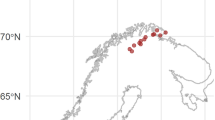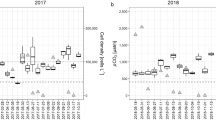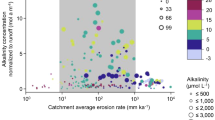Abstract
Most lakes and reservoirs have surface CO2 concentrations that are supersaturated relative to the atmosphere1. The resulting CO2 emissions from lakes represent a substantial contribution to the continental carbon balance2,3,4. Thus, the drivers of CO2 supersaturation in lakes need to be understood to constrain the sensitivity of the land carbon cycle to external perturbations4,5,6. Carbon dioxide supersaturation has generally been attributed to the accumulation of inorganic carbon in lakes where respiration exceeds photosynthesis7,8, but this interpretation has faced challenges9,10,11. Here we report analyses of water chemistry data from a survey of Spanish reservoirs that represent a range of lithologies, using simple metabolic models. We find that, above an alkalinity threshold of 1 mequiv. l−1, CO2 supersaturation in lakes is directly related to carbonate weathering in the watershed. We then evaluate the global distribution of alkalinity in lakes and find that 57% of the surface area occupied by lakes and reservoirs—particularly in tropical and temperate latitudes—has alkalinity exceeding 1 mequiv. l−1. We conclude that lake inputs of dissolved inorganic carbon from carbonate weathering should be considered for the CO2 supersaturation of lakes at both regional and global scales.
This is a preview of subscription content, access via your institution
Access options
Subscribe to this journal
Receive 12 print issues and online access
$259.00 per year
only $21.58 per issue
Buy this article
- Purchase on Springer Link
- Instant access to full article PDF
Prices may be subject to local taxes which are calculated during checkout



Similar content being viewed by others
References
Cole, J. J., Caraco, N. F., Kling, G. W. & Kratz, T. K. Carbon dioxide supersaturation in the surface waters of lakes. Science 265, 1568–1570 (1994).
Raymond, P. A. et al. Global carbon dioxide emissions from inland waters. Nature 503, 355–359 (2013).
Aufdenkampe, A. K. et al. Riverine coupling of biogeochemical cycles between land, oceans, and atmosphere. Front. Ecol. Environ. 9, 53–60 (2011).
Regnier, P. et al. Anthropogenic perturbation of the carbon fluxes from land to ocean. Nature Geosci. 6, 597–607 (2013).
Richey, J. E., Melack, J. M., Aufdenkampe, A. K., Ballester, V. M. & Hess, L. L. Outgassing from Amazonian rivers and wetlands as a large tropical source of atmospheric CO2 . Nature 416, 617–620 (2002).
Luyssaert, S. et al. The European carbon balance. Part 3: Forests. Glob. Change Biol. 16, 1429–1450 (2010).
Cole, J. J., Pace, M. L., Carpenter, S. R. & Kitchell, J. F. Persistence of net heterotrophy in lakes during nutrient addition and food web manipulations. Limnol. Oceanogr. 45, 1718–1730 (2000).
Duarte, C. M. & Prairie, Y. T. Prevalence of heterotrophy and atmospheric CO2 emissions from aquatic ecosystems. Ecosystems 8, 862–870 (2005).
Balmer, M. B. & Downing, J. Carbon dioxide concentrations in eutrophic lakes: Undersaturation implies atmospheric uptake. Inland Waters 1, 125–132 (2011).
Mcdonald, C. P., Stets, E. G., Striegl, R. G. & Butman, D. Inorganic carbon loading as a primary driver of dissolved carbon dioxide concentrations in the lakes and reservoirs of the contiguous United States. Glob. Biogeochem. Cycles 27, 285–295 (2013).
Maberly, S. C., Barker, P. A., Stott, A. W. & DeVille, M. M. Catchment productivity controls CO2 emissions from lakes. Nature Clim. Change 3, 391–394 (2013).
Bouillon, S. et al. Contrasting biogeochemical characteristics of the Oubangui River and tributaries (Congo River basin). Sci. Rep. 4, 5402 (2014).
Stets, E. G., Striegl, R. G., Aiken, G. R., Rosenberry, D. O. & Winter, T. C. Hydrologic support of carbon dioxide flux revealed by whole-lake carbon budgets. J. Geophys. Res. 114, G01008 (2009).
López, P., Marcé, R. & Armengol, J. Net heterotrophy and CO2 evasion from a productive calcareous reservoir: Adding complexity to the metabolism-CO2 evasion issue. J. Geophys. Res. 116, G02021 (2011).
Riera, J. L., Jaume, D., de Manuel, J., Morguí, J. A. & Armengol, J. Patterns of variation in the limnology of Spanish reservoirs: A regional study. Limnetica 8, 111–123 (1992).
Duarte, C. M. et al. CO2 emissions from saline lakes: A global estimate of a surprisingly large flux. J. Geophys. Res. 113, G04041 (2008).
Stabel, H. H. Calcite precipitation in Lake Constance: Chemical equilibrium, sedimentation, and nucleation by algae. Limnol. Oceanogr. 31, 1081–1093 (1986).
McConnaughey, T. A. & Whelan, J. F. Calcification generates protons for nutrient and bicarbonate uptake. Earth-Science Rev. 42, 95–117 (1997).
Riebesell, U. et al. Reduced calcification of marine plankton in response to increased atmospheric CO2 . Science 407, 364–367 (2000).
Dittrich, M., Kurz, P. & Wehrli, B. The role of autotrophic picocyanobacteria in calcite precipitation in an oligotrophic lake. Geomicrobiol. J. 21, 45–53 (2004).
Torgersen, T. & Branco, B. Carbon and oxygen dynamics of shallow aquatic systems: Process vectors and bacterial productivity. J. Geophys. Res. 112, G03016 (2007).
Mayorga, E. et al. Young organic matter as a source of carbon dioxide outgassing from Amazonian rivers. Nature 436, 538–541 (2005).
Lehner, B. & Döll, P. Development and validation of a global database of lakes, reservoirs and wetlands. J. Hydrol. 296, 1–22 (2004).
Lehner, B. et al. High-resolution mapping of the world’s reservoirs and dams for sustainable river-flow management. Front. Ecol. Environ. 9, 494–502 (2011).
Barros, N. et al. Carbon emission from hydroelectric reservoirs linked to reservoir age and latitude. Nature Geosci. 4, 593–596 (2011).
Butman, D. & Raymond, P. A. Significant efflux of carbon dioxide from streams and rivers in the United States. Nature Geosci. 4, 839–842 (2011).
Lapierre, J. F., Guillemette, F., Berggren, M. & del Giorgio, P. A. Increases in terrestrially derived carbon stimulate organic carbon processing and CO2 emissions in boreal aquatic ecosystems. Nature Commun. 4, 2972 (2013).
Hoellein, T. J., Bruesewitz, D. A. & Richardson, D. C. Revisiting Odum (1956): A synthesis of aquatic ecosystem metabolism. Limnol. Oceanogr. 58, 2089–2100 (2013).
Raymond, P. A., Oh, N-H., Turner, R. E. & Broussard, W. Anthropogenically enhanced fluxes of water and carbon from the Mississippi River. Nature 451, 449–452 (2008).
Markewitz, D. et al. Control of cation concentrations in stream waters by surface soil processes in an Amazonian watershed. Nature 410, 802–805 (2001).
Acknowledgements
Financial support for this research was provided by projects CARBONET (Spanish Ministry, CGL201130474C020), and SCARCE (Consolider-Ingenio 2010 CSD2009-00065). We are grateful to M. Koschorreck, N. Catalán, and D. von Schiller for comments on early drafts. This is a contribution of the NETLAKE group (COST Action ES1201).
Author information
Authors and Affiliations
Contributions
R.M. and B.O. conceived the paper and contributed equally to this work; J.L.R. and J-A.M. obtained the reservoir data during the 1987–1988 survey; R.M. and B.O. analysed the field data and R.M. performed worldwide computations; R.M. and B.O. co-wrote the paper. P.L. assisted in the interpretation of the data; J.A. designed and supervised the nationwide sampling. All authors discussed the results and commented on the manuscript.
Corresponding author
Ethics declarations
Competing interests
The authors declare no competing financial interests.
Supplementary information
Supplementary Information
Supplementary Information (PDF 1143 kb)
Supplementary Information
Supplementary Information (XLSX 28 kb)
Rights and permissions
About this article
Cite this article
Marcé, R., Obrador, B., Morguí, JA. et al. Carbonate weathering as a driver of CO2 supersaturation in lakes. Nature Geosci 8, 107–111 (2015). https://doi.org/10.1038/ngeo2341
Received:
Accepted:
Published:
Issue Date:
DOI: https://doi.org/10.1038/ngeo2341
This article is cited by
-
Methane and CO2 production in the wetland Lake Podpeč (Slovenia)
Journal of Soils and Sediments (2023)
-
Carbon dioxide partial pressure and its diffusion flux in karst surface aquatic ecosystems: a review
Acta Geochimica (2023)
-
Practical Guide to Measuring Wetland Carbon Pools and Fluxes
Wetlands (2023)
-
Drivers and variability of CO2:O2 saturation along a gradient from boreal to Arctic lakes
Scientific Reports (2022)
-
In-situ anatomical and elemental response of aquatic macrophytes against nutrient enrichment in freshwater tropical lakes
Applied Water Science (2022)



